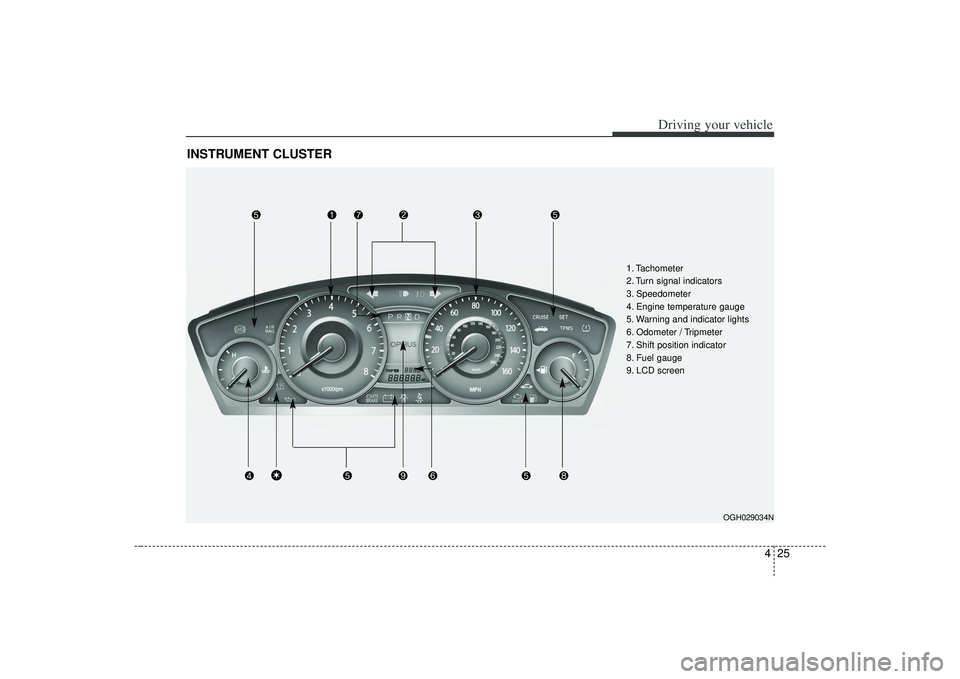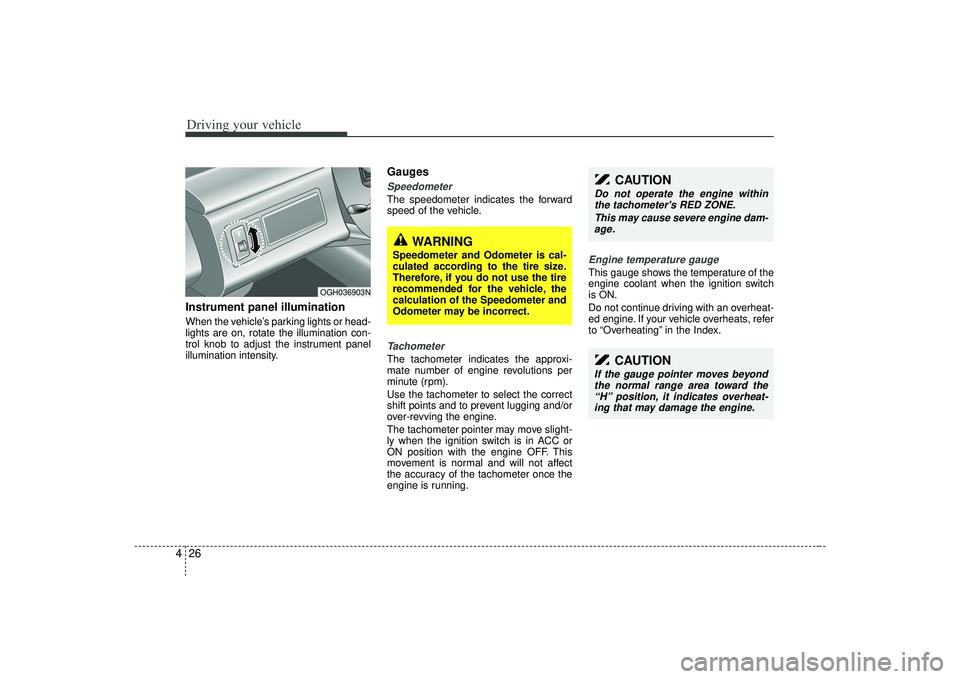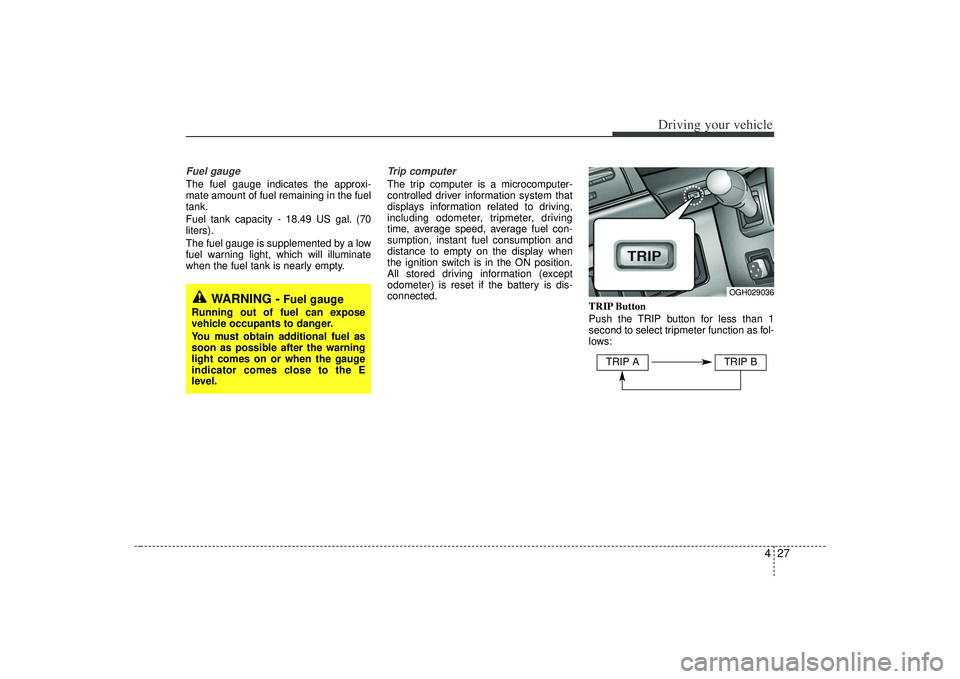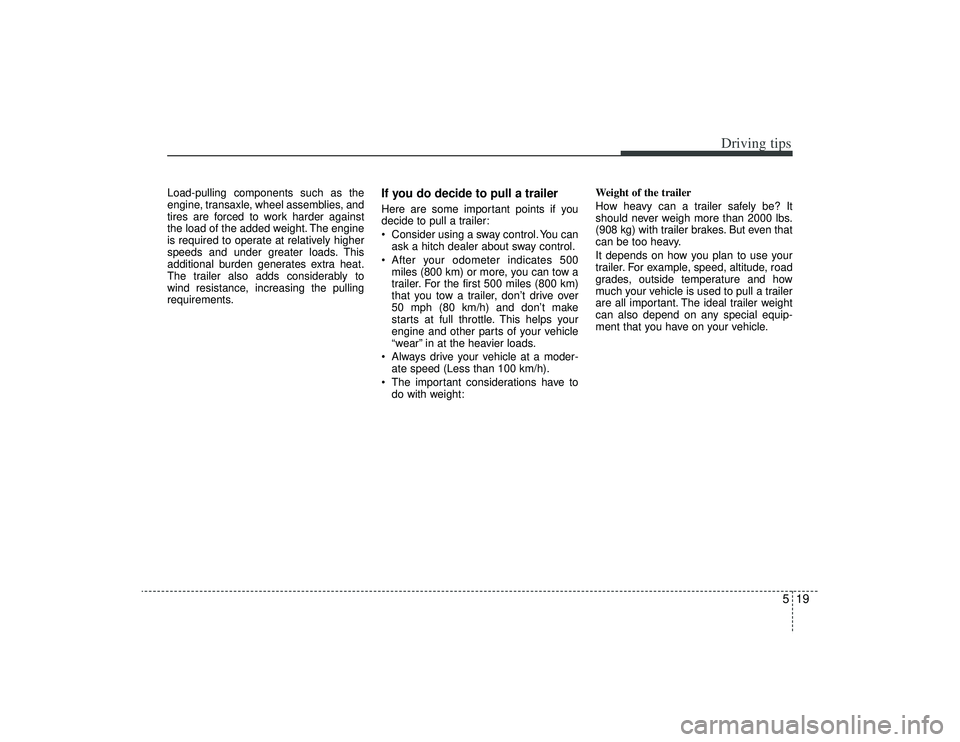odometer KIA AMANTI 2009 Owners Manual
[x] Cancel search | Manufacturer: KIA, Model Year: 2009, Model line: AMANTI, Model: KIA AMANTI 2009Pages: 321, PDF Size: 23.77 MB
Page 161 of 321

425
Driving your vehicle
INSTRUMENT CLUSTER
OGH029034N
1. Tachometer
2. Turn signal indicators
3. Speedometer
4. Engine temperature gauge
5. Warning and indicator lights
6. Odometer / Tripmeter
7. Shift position indicator
8. Fuel gauge
9. LCD screen
\b
Page 162 of 321

Driving your vehicle26
4Instrument panel illuminationWhen the vehicle’s parking lights or head-
lights are on, rotate the illumination con-
trol knob to adjust the instrument panel
illumination intensity.
GaugesSpeedometer The speedometer indicates the forward
speed of the vehicle.Tachometer The tachometer indicates the approxi-
mate number of engine revolutions per
minute (rpm).
Use the tachometer to select the correct
shift points and to prevent lugging and/or
over-revving the engine.
The tachometer pointer may move slight-
ly when the ignition switch is in ACC or
ON position with the engine OFF. This
movement is normal and will not affect
the accuracy of the tachometer once the
engine is running.
Engine temperature gauge This gauge shows the temperature of the
engine coolant when the ignition switch
is ON.
Do not continue driving with an overheat-
ed engine. If your vehicle overheats, refer
to “Overheating” in the Index.
CAUTION
Do not operate the engine within
the tachometer's RED ZONE.
This may cause severe engine dam-age.
CAUTION
If the gauge pointer moves beyond the normal range area toward the“H” position, it indicates overheat- ing that may damage the engine.
OGH036903N
WARNING
Speedometer and Odometer is cal-
culated according to the tire size.
Therefore, if you do not use the tire
recommended for the vehicle, the
calculation of the Speedometer and
Odometer may be incorrect.
Page 163 of 321

427
Driving your vehicle
Fuel gaugeThe fuel gauge indicates the approxi-
mate amount of fuel remaining in the fuel
tank.
Fuel tank capacity - 18.49 US gal. (70
liters).
The fuel gauge is supplemented by a low
fuel warning light, which will illuminate
when the fuel tank is nearly empty.
Trip computerThe trip computer is a microcomputer-
controlled driver information system that
displays information related to driving,
including odometer, tripmeter, driving
time, average speed, average fuel con-
sumption, instant fuel consumption and
distance to empty on the display when
the ignition switch is in the ON position.
All stored driving information (except
odometer) is reset if the battery is dis-
connected.TRIP Button
Push the TRIP button for less than 1
second to select tripmeter function as fol-
lows:
WARNING -
Fuel gauge
Running out of fuel can expose
vehicle occupants to danger.
You must obtain additional fuel as
soon as possible after the warning
light comes on or when the gauge
indicator comes close to the E
level.
OGH029036
TRIP A
TRIP B
Page 164 of 321

Driving your vehicle28
4Odometer (mi.)
The odometer indicates the total dis-
tance the vehicle has been driven. Tripmeter (mi.)
TRIP A : Tripmeter A
TRIP B : Tripmeter B
This mode indicates the distance of indi-
vidual trips selected since the last trip-
meter reset.
The meter's working range is from 0.0 to
999.9 miles.
Pressing the TRIP button for more than 1
second, when the tripmeter (TRIP A or
TRIP B) is being displayed, clears the
tripmeter to zero (0.0).MODE Button
Push the MODE Button for less than 1
second to select distance to empty, aver-
age fuel consumption , instant fuel con-
sumption, average speed, elapsed time
function as follows:
OGH029037N
OGH029038N
OGH029039
Distance to empty
Instant fuel consumptionAverage fuel consumption
Elapsed timeAverage speed
Page 211 of 321

519
Driving tips
Load-pulling components such as the
engine, transaxle, wheel assemblies, and
tires are forced to work harder against
the load of the added weight. The engine
is required to operate at relatively higher
speeds and under greater loads. This
additional burden generates extra heat.
The trailer also adds considerably to
wind resistance, increasing the pulling
requirements.
If you do decide to pull a trailerHere are some important points if you
decide to pull a trailer:
Consider using a sway control. You canask a hitch dealer about sway control.
After your odometer indicates 500 miles (800 km) or more, you can tow a
trailer. For the first 500 miles (800 km)
that you tow a trailer, don’t drive over
50 mph (80 km/h) and don’t make
starts at full throttle. This helps your
engine and other parts of your vehicle
“wear” in at the heavier loads.
Always drive your vehicle at a moder- ate speed (Less than 100 km/h).
The important considerations have to do with weight: Weight of the trailer
How heavy can a trailer safely be? It
should never weigh more than 2000 lbs.
(908 kg) with trailer brakes. But even that
can be too heavy.
It depends on how you plan to use your
trailer. For example, speed, altitude, road
grades, outside temperature and how
much your vehicle is used to pull a trailer
are all important. The ideal trailer weight
can also depend on any special equip-
ment that you have on your vehicle.
Page 279 of 321

729
Maintenance
TIRES AND WHEELS Tire care
For proper maintenance, safety, and
maximum fuel economy, you must
always maintain recommended tire
inflation pressures and stay within
the load limits and weight distribution
recommended for your vehicle.
Recommended cold tire inflation
pressures
All tire pressures (including the
spare) should be checked every day
when the tires are cold. “Cold Tires”
means the vehicle has not been driv-
en for at least three hours or driven
less than one mile (1.6 km).
Recommended pressures must be
maintained for the best ride, top vehi-
cle handling, and minimum tire wear.All specifications (sizes and pres-
sures) can be found on a label
attached to the vehicle.
3GHA523
XXX XX XX
XXX XX XXX XX
XXX XX
XXX XX XX
XXX XX XX
X
X
X
X X
X390390
860860390390
860860
OGH036905N
WARNING
- Tire underin-
flation
Severe underinflation (10 psi (70
kPa) or more) can lead to severe
heat build-up, causing blowouts,
tread separation and other tire
failures that can result in the
loss of vehicle control leading to
severe injury or death. This risk
is much higher on hot days and
when driving for protracted peri-
ods at high speeds.
WARNING
Speedometer and Odometer is
calculated according to the tire
size. Therefore, if you do not use
the tire recommended for the
vehicle, the calculation of the
Speedometer and Odometer may
be incorrect.
Page 317 of 321

Index6
10
LabelInformation ··················\
··················\
··················\
············5-25
Tire Specification/Pressure ··················\
··················\
······5-26
Lamp, Door Courtesy ··················\
··················\
················3-88
Lap/Shoulder Belt ··················\
··················\
··················\
····3-36 Rear··················\
··················\
··················\
··················\
······3-38
Webbing, Cleaning the ··················\
··················\
············7-51
Light Bulbs (Specifications) ··················\
··················\
···············8-2
Bulb Replacement, Headlight············\
··················\
········7-41
Bulb Replacement, Interior ··················\
··················\
·····7-43
Bulb Replacement, License Plate ··················\
··············7-44
Bulb Replacement, Rear Combination ··················\
······7-44
Dome ··················\
··················\
··················\
··················\
···3-88
Interior ··················\
··················\
··················\
··················\
·3-88
Map ··················\
··················\
··················\
··················\
······3-88
Lighter, Cigarette ··················\
··················\
··················\
·····3-91
Lighting Control ··················\
··················\
··················\
······4-41
Locks, Door ··················\
··················\
··················\
···············3-9
Low Fuel Level Warning ··················\
··················\
···········4-34
Low Washer Fluid Level Warning Indicator ·················4-35\
Lubricant Specifications ··················\
··················\
············7-46
Lubricants and Fluids ··················\
··················\
················7-20
Lumbar Support ··················\
··················\
··················\
·······3-21 Main Fuse ··················\
··················\
··················\
··················\
6-9
Maintenance ··················\
··················\
··················\
···············7-1
Normal - Schedule··················\
··················\
··················\
·· 7-3
Owner ··················\
··················\
··················\
··················\
····7-9
Severe - Schedule ··················\
··················\
··················\
····7-6
Services··················\
··················\
··················\
··················\
··7-2
Malfunction Indicator ··················\
··················\
················4-34
Mirror ··················\
··················\
··················\
··················\
·····3-84 Day/Night Rearview ··················\
··················\
················3-86
Outside Rearview ··················\
··················\
··················\
··3-84
Modifications, Vehicle ··················\
··················\
·················5-3
Odometer ··················\
··················\
··················\
·················4-26\
Oil Level, Checking the Engine ··················\
··················\
····7-13
Pressure Warning, Engine ··················\
··················\
·······4-32
One-Touch Wiper··················\
··················\
··················\
·····4-43
Outside Rearview Mirror ··················\
··················\
···········3-84
Overheating··················\
··················\
··················\
················6-3
Owner Maintenance ··················\
··················\
··················\
···7-9 Precautions··················\
··················\
··················\
·············7-11L
MO